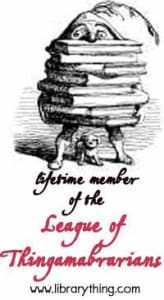Create a Home Library on a Budget
Love books? You need a home library! I love libraries. When I was a little kid, and people asked what I wanted to be when I grew up, I always said that I would be an author and a librarian. Many years later, I've written a few books (Excellence In Literature, Transcripts Made Easy, and Get a Jump Start on College), countless articles, and am working on many more. But I'm not a real librarian yet. Like many other booklovers, though, I've found ways to build a good home library without spending a fortune.
Education is an atmosphere
When Charlotte Mason wrote that "education is an atmosphere," she instinctively understood the benefits of living in the presence of books. Books are the quietest and most powerful educational influence you can offer your students. A home library is the informational heart of your home, a source of entertainment when the power goes out, and a source of lifelong pleasure and learning. Studies consistently show that children who grow up in homes with many books do much better in school than those whose minds have been starved.Before You Go Shopping
For best results when shopping for books, know what you want. My personal library numbers in the thousands, so I have to make sure I don't duplicate what I already own. I keep a list of authors I am looking for, as well as specific books I'd like to replace with a better copy. If you are new to library-building, you may want to read Who Should We Then Read I & II, by Jan Bloom of Books Bloom. I first encountered the Blooms at a home school conference, and discovered that Jan is a consistent source of excellent recommendations. Every time I walk into their book booth at one of the conferences, I leave with something wonderful. You'll find more Charlotte-Mason-friendly suggestions listed by grade level at AmblesideOnline.org or at MaterAmabalis.org. You'll find other good books in the guides below (your local library should have at least a few of these guides):- The Read-Aloud Family by Sarah Mackenzie
-
Books Children Love
by Elizabeth Wilson
-
Honey for a Child's Heart
by Gladys Hunt
-
The Well-Educated Mind
by Susan Wise Bauer
-
Invitation to the Classics
by Cowan and Guinness
-
The Read-Aloud Handbook
by Jim Trelease
If you need to fill your home library shelves and feed hungry minds, here are some ideas for where to look. I've listed them in order of affordability, with the cheapest options first.
Library Book Sales
In some areas of the country, library book sales are the very best way to grow a home library. I've bought hundreds of hardback books for .50 each, and often less, and as the end of the sale day approaches, the price usually drops even farther. You can sometimes fill an entire grocery bag for $1! You may not want to keep everything you pick up, but it's a cheap way to try new authors and to get books you can swap or sell.Coffee Shop Swaps
My local coffee shop has great coffee and squishy chairs, but best of all, it has a bunch of bookshelves. The deal is that you can take any book you like — you just bring back two to replace it. I've found terrific stuff there, and I always have plenty to donate (this is where you can take duplicates and leftovers from those library book bags!). I've heard that other coffee shops across the country offer similar opportunities, so be sure to check in your community. This is just one more good reason to patronize the local folks rather than the big anonymous chains.Paperback Book Swap
This internet-based swap site is a terrific way to get nice paperback books for just the cost of postage. You sign up, list books you'd like to give away, and wait for them to be requested. When you've earned a few credits, you may begin requesting books. When someone requests a book you've listed, you are notified by e-mail. You go to the swap site, and confirm that you can send the book, then print out the wrapper, which is two sheets of ordinary printer paper with all the mailing information, printed on. You fold this around your book, tape it, and send it off. It works beautifully! It's free to join and swap.Thrift Shops
Large thrift stores usually have a book section, and it's almost always possible to find something good. Some thrift stores receive nearly new books from the bestseller list. These aren't the type of thing I read, but I sometimes buy them to swap or resell, if they are cheap enough. I've noticed that some of the big chain thrift stores such as Good Will are beginning to price books higher than I want to pay, but the small, individually operated thrift stores often have a wide selection under $1 each.Used Book Swap Stores
These small, individually owned stores usually focus on paperback books, but many have a section of quality older books, including non-fiction and classics. Prices are usually set at half the original price of the book, or $1, whichever is greater. If you want to bring in books to swap, you receive credit for 25% of the resale value. Most of these mom-and-pop operations don't keep elaborate records, so it can be up to you to keep track of your credits. I solved this potential headache by never bringing in more than I bought!Online Book Stores
If you're looking for a particular book or author, chances are that the internet is the fastest place to find it. You can still find some great deals on eBay and other auction sites, but don't forget to factor in the cost of shipping and handling. I buy most of my new books at Amazon.com, as their prices are usually best, and they offer fast, free shipping with Prime Membership (You can try Amazon Prime free for 30 DaysGreen Valley Book Fair
Residents of the mid-Atlantic region of the United States are lucky-- they can easily get to the 25,000 square foot Green Valley Book Fair when it is open. This warehouse in the Shenandoah Valley of Virginia is open about six times a year, for about two weeks at a time. Prices for new books are stunningly low (60-90% off retail), and the selection tends to be similar to what you find at the big bookstores. It's worth a trip if you're anywhere near. You can find the current schedule and directions at their website, www.gvbookfair.com.Antiquarian and Independent Book Stores
I love browsing in antiquarian book shops for their quirky selection and cozy atmosphere, but prices are often downright shocking. However, there's always the chance that you'll find something shabby but wonderful lurking on a back shelf. These shops often have sale racks that are quite reasonable. I still mourn the loss of Acres of Books in Long Beach, but The Last Bookstore is a good substitute and Riverby Books in Virginia is another. My other favorite is Shakespeare and Company in Paris. They're decently organized, full of treasures, and it's possible to find great bargains. Readers tend to be opinionated about book stores, so there are many lists of "best independent bookstores" online, but the best place to start looking for unique selections and helpful booksellers is with the stores closest to you. Independent book stores tend to be started by the most interesting people in town, and their book selections are often as interesting and offbeat as they are. Some of my favorite independent new-book stores are Eighth Day Books and Powell's.New Book Stores
Many large chain book stores have a bargain book section where you can occasionally find good books marked 50-75% off. Some chains, like Barnes & Noble, also publish their own line of classics at relatively reasonable prices. They usually aren't the best translations available, but can be useful if you are unable to find a good used copy elsewhere.After You Go Shopping
Catalog Your Books
 Once you've begun to collect books, it's a good idea to catalog them. I catalog a few of my books on LibraryThing.com, and have an account at GoodReads, too, which is a more socially oriented site. Either can be helpful when you're standing before a table of used books wondering if you already have the one you're looking at.
Once you've begun to collect books, it's a good idea to catalog them. I catalog a few of my books on LibraryThing.com, and have an account at GoodReads, too, which is a more socially oriented site. Either can be helpful when you're standing before a table of used books wondering if you already have the one you're looking at.
When I was young and my collection was small, I could remember all I had, but that soon passed. Now, I need all the help I can get in remembering what I need, and what I already have.
Neither LibraryThing nor GoodReads contains my entire book collection — chalk that up to the fact that I had 5000 or so books before I started cataloguing. However, I recently discovered an iPhone app that is helping me add more books to my inventory list.
With Shelfie, you take a photo of a book shelf, and the app will identify the books on it and present a list for your approval. You are able to select and accept those that are correctly identified, and they are added to your library. As a bonus, the app will let you know if there are free or discounted ebooks or audiobooks available for the books you already own. I don't love ebooks, but if I'm stuck in an airport and need another book, it's nice to have access to something I actually want to read.
Build Sturdy Bookshelves
If you begin building a serious library, you'll soon find that you need bookshelves. Lots of bookshelves. I've found that sheets of particleboard can be sawed into 6" deep strips at a pretty reasonable cost per shelf. A 4' x 8' sheet of particleboard can yield a pretty decent ceiling-height bookcase.
First, saw off two 6" by 8' strips, then saw the remainder of the board into 6" x 32" strips. Screw it all together, and it's pretty sturdy. Be sure to leave space at the top to run a strip of trim around it to connect it to the wall. Never leave it unanchored, or it may fall over!
For added sturdiness, you can cut three 2" wide strips from the long edge of the sheet of particleboard before cutting the shelves. Screw these to the edges and center of the back, and screw them into the wall, and the bookcase should be very secure.
With a little imagination, you can customize these simple shelves to march up a flight of stairs, or wrap around a room. Your library will soon be looking good! The bottom line is, you can have a great home library without paying anywhere near new book prices.
As your collection starts to grow, people will often offer you their unwanted books. Take them! If you don't need them, you can share them with others, swap them, or even sell them and buy books you need. Someone somewhere is probably looking for a book you want to give away. Take care of your books by protecting them from moisture and insects, and they will repay you with hours of pleasure.
NOTE: All Amazon links are affiliate links (see Disclosure below).
Want to learn more about Charlotte Mason and her methods? Her six-book series is just what you need. You can read The Benefits of Reading and Seven Tips on the blog.

